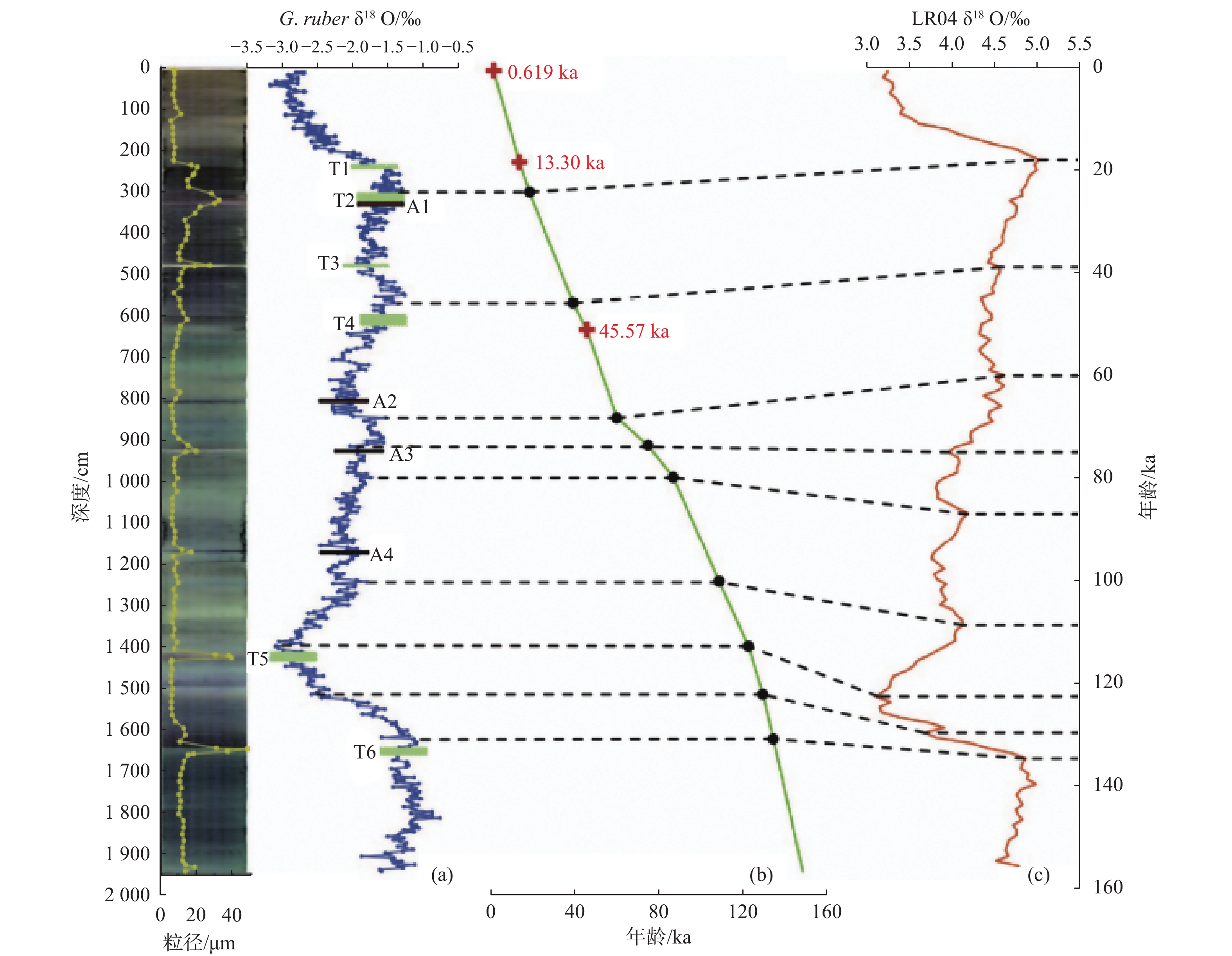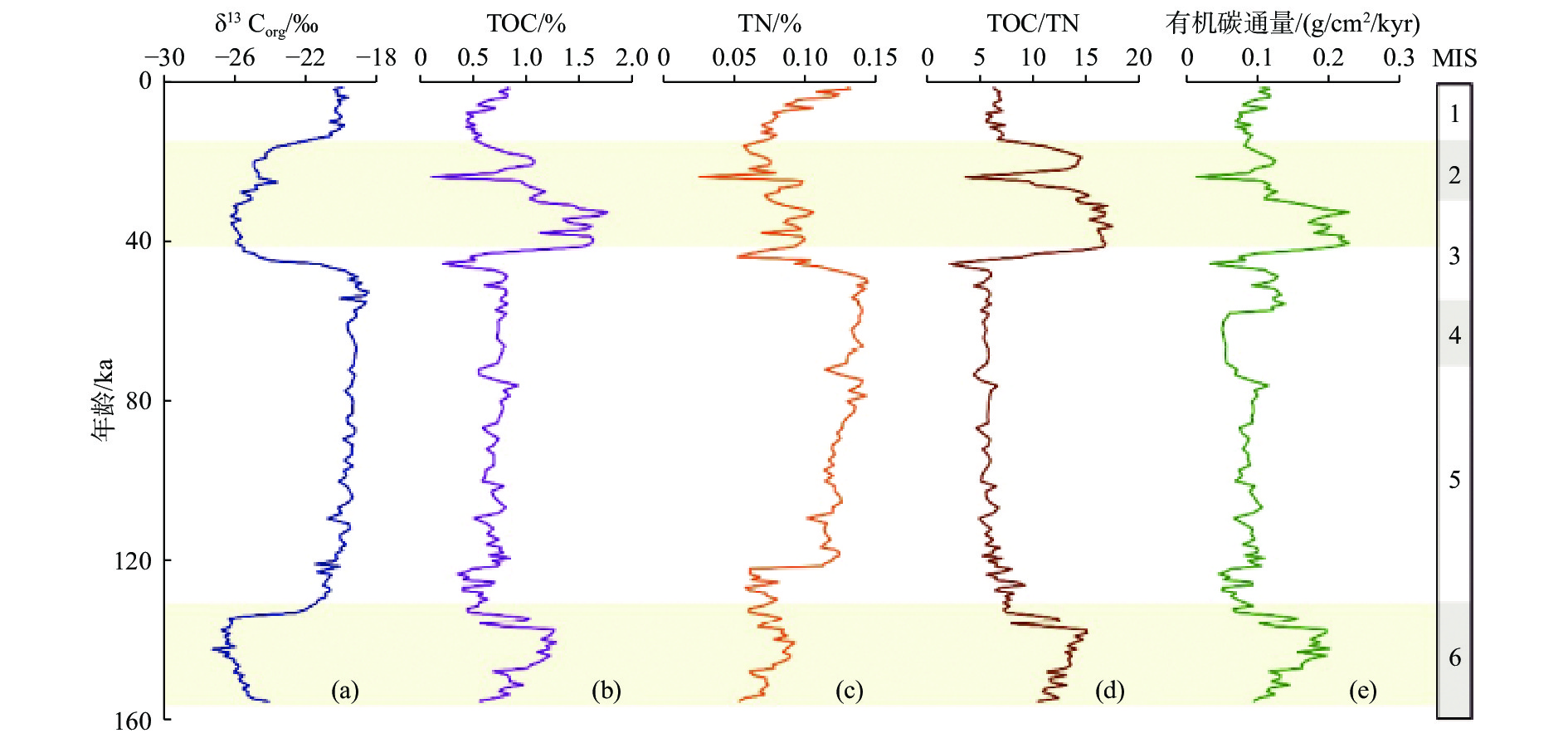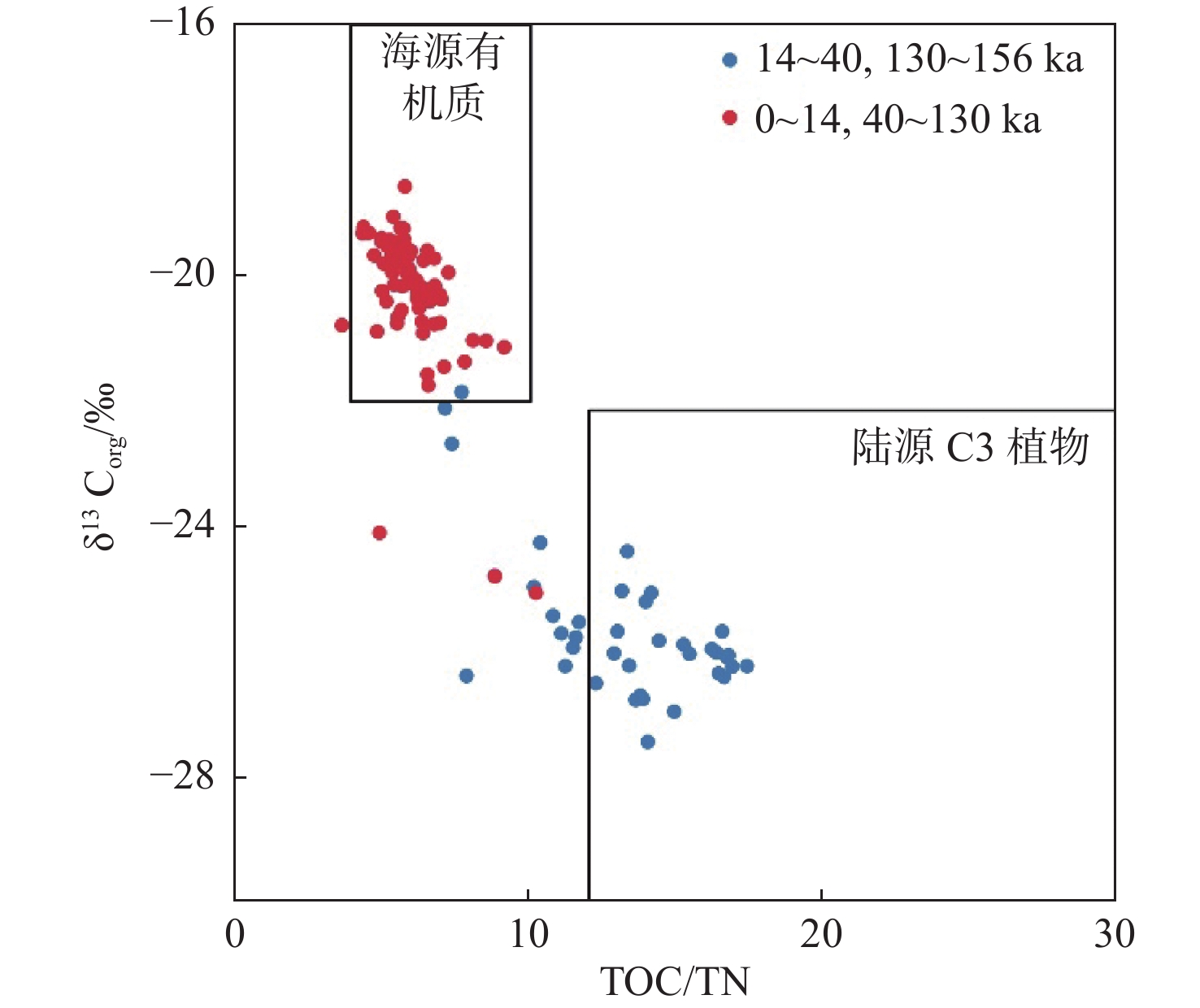Quantitative source-to-sink processes and carbon cycling effect of sediment on the continental slope of the western Philippine Sea since 156 ka
-
摘要:
通过对西菲律宾海大陆坡上MD06-3052岩芯沉积物中有机质稳定碳同位素组成(δ13Corg)的分析,结合该孔有机碳含量、总氮含量、沉积物不同组分通量以及陆源区风化剥蚀指标等数据,探讨了156 ka以来冰期-间冰期旋回中研究区有机质的定量源-汇过程、主控因素及其碳循环效应。结果表明:δ13Corg值在−27.4‰~−18.6‰波动,平均值为−22.2‰,且呈现出冰期相对偏负而间冰期相对偏正的变化特征,有机质的具体来源包括海洋生物和陆地C3植物,在冰期和间冰期阶段分别以陆源(平均约为67%)和海源(平均约为83%)有机质的贡献为主。陆源有机碳含量和通量的变化趋势与总有机碳相应指标非常一致,均具有冰期高而间冰期低的特征,表明研究区冰期阶段有机碳通量增加的最主要原因是海平面下降所引起的大陆架出露及其上松散硅酸盐沉积物的强物理剥蚀作用。再结合热带西太平洋其他岩芯的相似记录,认为当时热带广泛出露大陆架上的强硅酸盐风化剥蚀作用及与其相伴随的高海底有机碳埋藏通量在大气CO2浓度降低和全球变冷中有着非常重要的贡献。
Abstract:We analyzed the stable carbon isotopic composition (δ13Corg) of organic matter in Core MD06-3052 retrieved from the continental slope of the western Philippine Sea. The new data, together with the published ones from the same core, including total organic carbon content, total nitrogen content, fluxes of different sediment components, and continental weathering and erosion proxies, were combined to constrain the quantitative source-to-sink processes, main controlling factors, and their carbon cycling effects of organic matter in the study area since 156 ka during glacial-interglacial cycles. Results show that the δ13Corg values fluctuate between −27.4‰ and −18.6‰ on average of −22.2‰, and are characterized by a variation characteristic of relatively negative values during the glacial periods and relatively positive values during the interglacial periods. The sources of organic matter included marine organisms and terrestrial C3 plants, dominated by terrestrial provenance (about 67% on average) and marine provenance (average 83%) during the glacial and interglacial periods, respectively. The variation trends of terrigenous organic carbon content and flux are very similar to those of the total organic carbon, and characterized by higher values during the glacial periods and lower values during the interglacial periods, indicating that the main reason for the increased organic carbon fluxes is continental shelf exposure during the glacial periods at sea level drop, and thus the strong weathering and erosion of loose silicate sediments. Combined with similar records of other cores in the tropical Western Pacific, we conclude that strong weathering and erosion of silicates on the widely exposed continental shelves and the associated high organic carbon burial flux in the sea during three stages could contribute greatly to the reduction of atmospheric carbon dioxide concentration, and consequent global cooling.
-
Key words:
- western Philippine Sea /
- organic matter source /
- sea level change /
- glacial-interglacial /
- carbon cycle
-

-
图 2 MD06-3052孔的岩芯照片、平均粒径变化和年龄框架[35]
Figure 2.
图 3 MD06-3052岩芯δ13Corg和TOC含量、TN含量及有机碳通量[31]的剖面变化
Figure 3.
-
[1] MASSON-DELMOTTE V, ZHAI P, PIRANI A, et al. Climate Change 2021: the physical science basis, contribution of working group I to the sixth assessment report of the Intergovernmental Panel on Climate Change[R]. Cambridge University Press, 2021.
[2] LÜTHI D,LE FLOCH M,BEREITER B,et al. High-resolution carbon dioxide concentration record 650 000-800 000 years before present[J]. Nature,2008,453(7193):379-382. doi: 10.1038/nature06949
[3] WANG P X. Low-latitude forcing:a new insight into paleo-climate changes[J]. The Innovation,2021,2(3):100145. doi: 10.1016/j.xinn.2021.100145
[4] MARTIN J H. Glacial-interglacial CO2 change:the iron hypothesis[J]. Paleoceanography,1990,5(1):1-13. doi: 10.1029/PA005i001p00001
[5] OPDYKE B N,WALKER J C G. Return of the coral-reef hypothesis:basin to shelf partitioning of CaCO3 and its effect on atmospheric CO2[J]. Geology,1992,20(8):733-736. doi: 10.1130/0091-7613(1992)020<0733:ROTCRH>2.3.CO;2
[6] SIGMAN D M,BOYLE E A. Glacial/interglacial variations in atmospheric carbon dioxide[J]. Nature,2000,407(6806):859-869. doi: 10.1038/35038000
[7] SIGMAN D M,HAIN M P,HAUG G H. The polar ocean and glacial cycles in atmospheric CO2 concentration[J]. Nature,2010,466(7302):47-55. doi: 10.1038/nature09149
[8] JACCARD S L,GALBRAITH E D,SIGMAN D M,et al. Subarctic Pacific evidence for a glacial deepening of the oceanic respired carbon pool[J]. Earth and Planetary Science Letters,2009,277(1/2):156-165. doi: 10.1016/j.jpgl.2008.10.017
[9] WAN S M,CLIFT P D,ZHAO D B,et al. Enhanced silicate weathering of tropical shelf sediments exposed during glacial lowstands:a sink for atmospheric CO2[J]. Geochimica et Cosmochimica Acta,2017,200:123-144. doi: 10.1016/j.gca.2016.12.010
[10] HILTON R G,WEST A J. Mountains,erosion and the carbon cycle[J]. Nature Reviews Earth and Environment,2020,1(6):284-299.
[11] HARTMANN J,JANSEN N,DURR H H,et al. Global CO2-consumption by chemical weathering:what is the contribution of highly active weathering regions?[J]. Global and Planetary Change,2009,69(4):185-194. doi: 10.1016/j.gloplacha.2009.07.007
[12] LUDWIG W,AMIOTTE-SUCHET P,PROBST J L. Enhanced chemical weathering of rocks during the last glacial maximum:a sink for atmospheric CO2?[J]. Chemical Geology,1999,159(1/4):147-161.
[13] XU Z K,LI T G,CLIFT P D,et al. Bathyal records of enhanced silicate erosion and weathering on the exposed Luzon shelf during glacial lowstands and their significance for atmospheric CO2 sink[J]. Chemical Geology,2018,476:302-315. doi: 10.1016/j.chemgeo.2017.11.027
[14] 万世明,秦琳,杨守业,等. 南海冰期陆架风化与碳循环[J]. 第四纪研究,2020,40(6):1532-1549.
[15] XU Z K,WAN S M,COLIN C,et al. Enhancements of Himalayan and Xizang erosion and the produced organic carbon burial in distal tropical marginal seas during the Quaternary glacial periods:an integration of sedimentary records[J]. Journal of Geophysical Research:Earth Surface,2021,126(3):e2020JF005828.
[16] BERNER R A. Biogeochemical cycles of carbon and sulfur and their effect on atmospheric oxygen over phanerozoic time[J]. Global and Planetary Change,1989,75(1/2):97-122.
[17] HEDGES J I,KEIL R G. Sedimentary organic matter preservation:an assessment and speculative synthesis[J]. Marine Chemistry,1995,49(2/3):81-115. doi: 10.1016/0304-4203(95)00008-F
[18] BURDIGE D J. Burial of terrestrial organic matter in marine sediments:a re-assessment[J]. Global Biogeochemical Cycles,2005,19(4):GB4011.
[19] CARTAPANIS O,BIANCHI D,JACCARD S L,et al. Global pulses of organic carbon burial in deep-sea sediments during glacial maxima[J]. Nature Communications,2016,7:10796. doi: 10.1038/ncomms10796
[20] CHEN L Y,LUO M,DALE A W,et al. Reconstructing organic matter sources and rain rates in the southern West Pacific Warm Pool during the transition from the deglaciation period to early Holocene[J]. Chemical Geology,2019,529:119291. doi: 10.1016/j.chemgeo.2019.119291
[21] 秦琳,万世明. 末次冰期以来南海东北部陆源有机碳埋藏通量演变-海平面和季风驱动[J]. 海洋与湖沼,2020,51(4):875-888.
[22] WAN S M,YU Z J,CLIFT P D,et al. History of Asian eolian input to the West Philippine Sea over the last one million years[J]. Palaeogeography,Palaeoclimatology,Palaeoecology,2012,326-328:152-159.
[23] XU Z K,LI T G,WAN S M,et al. Evolution of East Asian monsoon:clay mineral evidence in the western Philippine Sea over the past 700 kyr[J]. Journal of Asian Earth Sciences,2012,60:188-196. doi: 10.1016/j.jseaes.2012.08.018
[24] JIANG F Q,FRANK M,LI T G,et al. Asian dust input in the western Philippine Sea:evidence from radiogenic Sr and Nd isotopes[J]. Geochemistry,Geophysics,Geosystems,2013,14(5):1538-1551.
[25] XU Z K,LI T G,CLIFT P D,et al. Quantitative estimates of Asian dust input to the western Philippine Sea in the mid-late Quaternary and its potential significance for paleoenvironment[J]. Geochemistry,Geophysics,Geosystems,2015,16(9):3182-3196.
[26] XIONG Z F,LI T G,CHANG F M,et al. Rapid precipitation changes in the tropical West Pacific linked to North Atlantic climate forcing during the last deglaciation[J]. Quaternary Science Reviews,2018,197:288-306. doi: 10.1016/j.quascirev.2018.07.040
[27] MILLIMAN J D,SYVITSKI J P M. Geomorphic/tectonic control of sediment discharge to the ocean:the importance of small mountainous rivers[J]. The Journal of Geology,1992,100(5):525-544. doi: 10.1086/629606
[28] LYONS W B,NEZAT C A,CAREY A E,et al. Organic carbon fluxes to the ocean from high-standing islands[J]. Geology,2002,30(5):443-446. doi: 10.1130/0091-7613(2002)030<0443:OCFTTO>2.0.CO;2
[29] LIU Z F,ZHAO Y L,COLIN C,et al. Chemical weathering in Luzon,Philippines from clay mineralogy and major-element geochemistry of river sediments[J]. Applied Geochemistry,2009,24(11):2195-2205. doi: 10.1016/j.apgeochem.2009.09.025
[30] SCHOPKA H H,DERRY L A,ARCILLA C A. Chemical weathering,river geochemistry and atmospheric carbon fluxes from volcanic and ultramafic regions on Luzon Island,the Philippines[J]. Geochimica et Cosmochimica Acta,2011,75(4):978-1002. doi: 10.1016/j.gca.2010.11.014
[31] XU Z K,WAN S M,COLIN C,et al. Enhanced terrigenous organic matter input and productivity on the western margin of the Western Pacific Warm Pool during the Quaternary sea-level lowstands:forcing mechanisms and implications for the global carbon cycle[J]. Quaternary Science Reviews,2020,232:106211. doi: 10.1016/j.quascirev.2020.106211
[32] QIU X H,LI T G,CHANG F M,et al. Sea surface temperature and salinity reconstruction based on stable isotopes and Mg/Ca of planktonic foraminifera in the western Pacific Warm Pool during the last 155 ka[J]. Chinese Journal of Oceanology and Limnology,2014,32(1):187-200. doi: 10.1007/s00343-014-3073-y
[33] PELEJERO C. Terrigenous n-alkane input in the South China Sea:high-resolution records and surface sediments[J]. Chemical Geology,2003,200(1/2):89-103. doi: 10.1016/S0009-2541(03)00164-5
[34] 李丽,王慧,罗布次仁,等. 南海北部4万年以来有机碳和碳酸盐含量变化及古海洋学意义[J]. 海洋地质与第四纪地质,2008,28(6):79-85.
[35] ZHANG Z S,JIANG F Q,LI T G,et al. Sea-level changes controlled detrital sediment inputs to the Bicol Shelf in the western Philippine Sea since 150 ka[J]. Journal of Oceanology and Limnology,2020,38(4):1153-1168. doi: 10.1007/s00343-020-0051-4
[36] HEDGES J I,KEIL R G,BENNER R. What happens to terrestrial organic matter in the ocean?[J]. Organic Geochemistry,1997,27(5/6):195-212.
[37] MEYERS P A. Organic geochemical proxies of paleoceanographic,paleolimnologic,and paleoclimatic processes[J]. Organic Geochemistry,1997,27(5/6):213-250.
[38] BURDIGE D J. Preservation of organic matter in marine sediments:controls,mechanisms,and an imbalance in sediment organic carbon budgets?[J]. Chemical Reviews,2007,107(2):467-485. doi: 10.1021/cr050347q
[39] GONI M A,MONACCI N,GISEWHITE R,et al. Terrigenous organic matter in sediments from the Fly River delta-clinoform system (Papua New Guinea)[J]. Journal of Geophysical Research,2008,113:F01S10.
[40] MEYERS P A. Preservation of elemental and isotopic source identification of sedimentary organic matter[J]. Chemical Geology,1994,114(3/4):289-302.
[41] LAMB A L,WILSON G P,LENG M J. A review of coastal palaeoclimate and relative sea-level reconstructions using δ13C and C/N ratios in organic material[J]. Earth-Science Reviews,2006,75(1/4):29-57.
[42] 于兆杰,万世明,孙晗杰,等. 近百万年来亚洲风尘在西菲律宾海的沉积物粒度记录[J]. 地球环境学报,2012,3(2):792-800. doi: 10.7515/JEE201202005
[43] LIN B Z,LIU Z F,EGLINTON T I,et al. Organic matter compositions and loadings in river sediments from humid tropical volcanic Luzon Island of the Philippines[J]. Journal of Geophysical Research:Biogeosciences,2021,126:e2020JG006192.
[44] OGAWA Y,OKAMOTO Y,SADABA R B,et al. Sediment organic matter source estimation and ecological classification in the semi-enclosed Batan Bay Estuary,Philippines[J]. International Journal of Sediment Research,2021,36(1):110-119. doi: 10.1016/j.ijsrc.2020.05.007
[45] BINTANJA R,VAN DE WAL R S,OERLEMANS J. Modelled atmospheric temperatures and global sea levels over the past million years[J]. Nature,2005,437(7055):125-128. doi: 10.1038/nature03975
[46] XU Z K,LI T G,CLIFT P D,et al. Sea-level,monsoonal,and anthropogenic impacts on the millennial-scale variability of siliciclastic sediment input into the Western Philippine Sea since 27 ka[J]. Journal of Asian Earth Sciences,2019,177:250-262. doi: 10.1016/j.jseaes.2019.04.001
[47] SUN X J,LI X,LUO Y L,et al. The vegetation and climate at the last glaciation on the emerged continental shelf of the South China Sea[J]. Palaeogeography,Palaeoclimatology,Palaeoecology,2000,160(3/4):301-316.
-




 下载:
下载:





